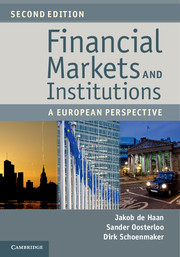Book contents
- Frontmatter
- Contents
- List of Boxes
- List of Figures
- List of Tables
- List of Countries
- List of Abbreviations
- Preface
- Part I Setting the Stage
- Part II Financial Markets
- Chapter 5 European Financial Markets
- Chapter 6 The Economics of Financial Integration
- Chapter 7 Financial Infrastructures
- Chapter 8 Financial Innovation
- Part III Financial Institutions
- Part IV Policies for the Financial Sector
- Index
- References
Chapter 5 - European Financial Markets
from Part II - Financial Markets
- Frontmatter
- Contents
- List of Boxes
- List of Figures
- List of Tables
- List of Countries
- List of Abbreviations
- Preface
- Part I Setting the Stage
- Part II Financial Markets
- Chapter 5 European Financial Markets
- Chapter 6 The Economics of Financial Integration
- Chapter 7 Financial Infrastructures
- Chapter 8 Financial Innovation
- Part III Financial Institutions
- Part IV Policies for the Financial Sector
- Index
- References
Summary
Overview
This chapter starts off by reviewing the functions that financial markets perform. First, financial markets release information to aid the price discovery process. Second, markets provide a platform to trade. The main trading mechanisms, i.e. quote-driven and order-driven markets, are discussed. Finally, markets provide an infrastructure to settle trades. The remainder of the chapter describes the main financial markets in the EU (the money, bond, equity, derivatives, and foreign exchange markets).
The euro money market is the market for euro-denominated short-term funds and related derivative instruments. It consists of various segments, including unsecured deposit contracts with various maturities, ranging from overnight to one year, and repurchase agreements (so-called repos, i.e. reverse transactions secured by securities) also ranging from overnight to one year. Banks account for the largest share of the euro money market. The ECB has a major infl uence on the money market via its use of various monetary policy instruments (reserve requirements, standing facilities, and open market operations). There are three main market interest rates for the money market: EONIA (euro overnight index average), EURIBOR (euro interbank offered rate), and EUREPO (the repo market reference rate for the euro).
- Type
- Chapter
- Information
- Financial Markets and InstitutionsA European Perspective, pp. 129 - 168Publisher: Cambridge University PressPrint publication year: 2012
References
- 6
- Cited by



